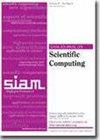Rank-Minimizing and Structured Model Inference
IF 2.6
2区 数学
Q1 MATHEMATICS, APPLIED
引用次数: 0
Abstract
SIAM Journal on Scientific Computing, Volume 46, Issue 3, Page A1879-A1902, June 2024.Abstract. While extracting information from data with machine learning plays an increasingly important role, physical laws and other first principles continue to provide critical insights about systems and processes of interest in science and engineering. This work introduces a method that infers models from data with physical insights encoded in the form of structure and that minimizes the model order so that the training data are fitted well while redundant degrees of freedom without conditions and sufficient data to fix them are automatically eliminated. The models are formulated via solution matrices of specific instances of generalized Sylvester equations that enforce interpolation of the training data and relate the model order to the rank of the solution matrices. The proposed method numerically solves the Sylvester equations for minimal-rank solutions and so obtains models of low order. Numerical experiments demonstrate that the combination of structure preservation and rank minimization leads to accurate models with orders of magnitude fewer degrees of freedom than models of comparable prediction quality that are learned with structure preservation alone.
秩最小化和结构化模型推理
SIAM 科学计算期刊》,第 46 卷第 3 期,第 A1879-A1902 页,2024 年 6 月。 摘要尽管利用机器学习从数据中提取信息发挥着越来越重要的作用,但物理定律和其他第一性原理仍能为科学和工程领域感兴趣的系统和过程提供至关重要的见解。这项工作介绍了一种方法,它能从数据中推导出以结构形式编码的物理洞察力模型,并使模型阶数最小化,从而很好地拟合训练数据,同时自动消除没有条件和足够数据来固定的冗余自由度。模型是通过广义西尔维斯特方程具体实例的解矩阵来建立的,它强制对训练数据进行插值,并将模型阶数与解矩阵的秩相关联。所提出的方法通过数值求解最小秩的西尔维斯特方程,从而获得低阶模型。数值实验证明,将结构保持和秩最小化结合起来,可以得到精确的模型,其自由度要比仅用结构保持方法学习到的预测质量相当的模型少几个数量级。
本文章由计算机程序翻译,如有差异,请以英文原文为准。
求助全文
约1分钟内获得全文
求助全文
来源期刊
CiteScore
5.50
自引率
3.20%
发文量
209
审稿时长
1 months
期刊介绍:
The purpose of SIAM Journal on Scientific Computing (SISC) is to advance computational methods for solving scientific and engineering problems.
SISC papers are classified into three categories:
1. Methods and Algorithms for Scientific Computing: Papers in this category may include theoretical analysis, provided that the relevance to applications in science and engineering is demonstrated. They should contain meaningful computational results and theoretical results or strong heuristics supporting the performance of new algorithms.
2. Computational Methods in Science and Engineering: Papers in this section will typically describe novel methodologies for solving a specific problem in computational science or engineering. They should contain enough information about the application to orient other computational scientists but should omit details of interest mainly to the applications specialist.
3. Software and High-Performance Computing: Papers in this category should concern the novel design and development of computational methods and high-quality software, parallel algorithms, high-performance computing issues, new architectures, data analysis, or visualization. The primary focus should be on computational methods that have potentially large impact for an important class of scientific or engineering problems.

 求助内容:
求助内容: 应助结果提醒方式:
应助结果提醒方式:


